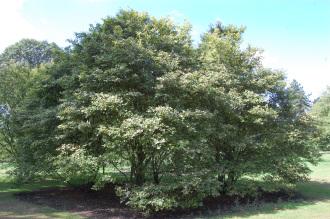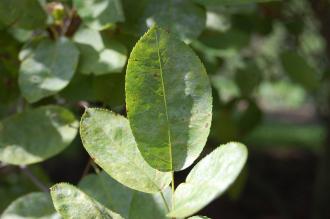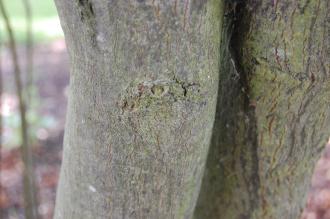
Amelanchier canadensis Grove (15/08/2105, Kew Gardens, London)
Position: Full sun to partial shade
Flowering period: Spring
Soil: Moist, well drained
Eventual Height: 8m
Eventual Spread: 3m
Hardiness: 4a, 4b, 5a, 5b, 6a, 6b, 7a, 7b, 8a, 8b
Family: Rosaceae
Amelanchier canadensis is a deciduous shrub or small tree with an upright open habit, often with multi stems. Its mid green leaves are ovate with serrulate margins, up to 6.5cm long and 4cm broad. Its leaves turn orange/ red in autumn before they fall. Its silver/ gray bark is smooth. Its white flowers are star shaped and are arranged in loose racemes which are up to 6cm long and appear terminally. Its fruit is a pome, initially green, becoming dark purple when mature and up to 1cm across. Its roots may produce suckers.

Amelanchier canadensis Leaf (15/08/2105, Kew Gardens, London)
Amelanchier canadensis, commonly known as the Canadian Serviceberry, Chuchkberry, Juneberry or Serviceberry, is native to east North America, including east Canada and east USA.
The etymological root of the binomial name Amelanchier is from French Provencal name ‘Amelancier’, an old name for Amelanchier ovalis. Canadensis is derived from the Latin meaning ‘from Canada’.
The landscape architect may find Amelanchier canadensis useful as a small specimen tree with attractive spring flowers, particularly in a partially shaded site. It may also be planted as a hedging species.

Amelanchier canadensis Bark (15/08/2105, Kew Gardens, London)
Ecologically, Amelanchier canadensis flowers are attractive to pollinating insects. Its fruit are attractive to birds and mammals.
Amelanchier canadensis prefers moist to wet, humus rich, well-drained soils. It prefers an acid to neutral pH of soil. It dislikes dry soils.
Amelanchier canadensis requires little maintenance. Any necessary pruning or hedge maintenance should be carried out after flowering.

Landscape Architecture

